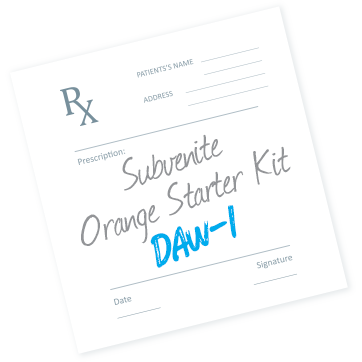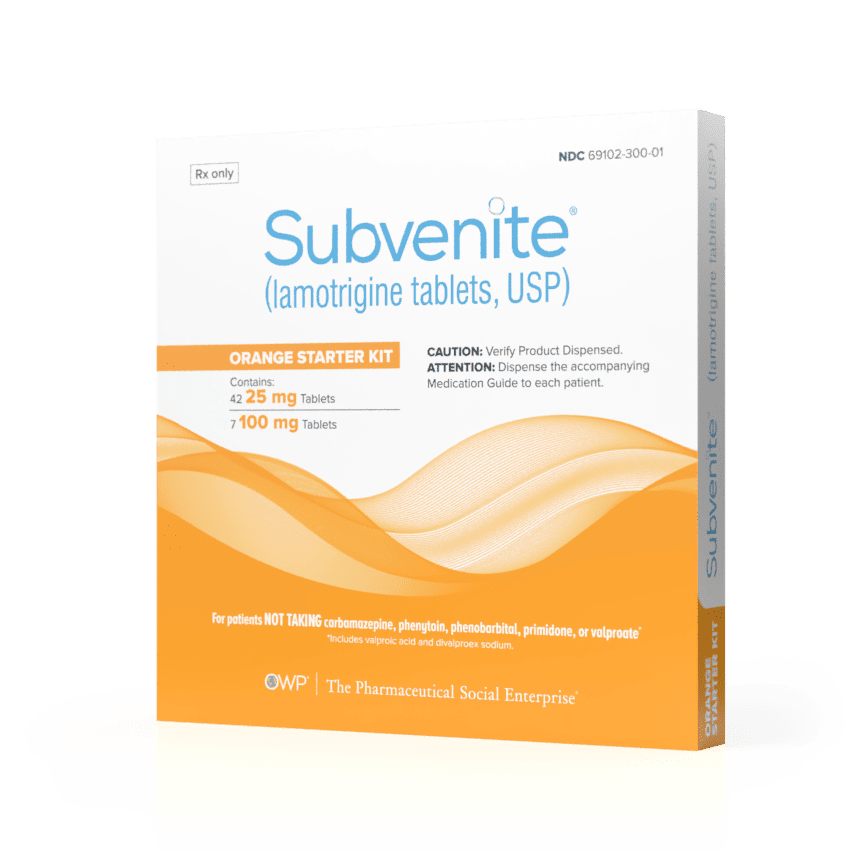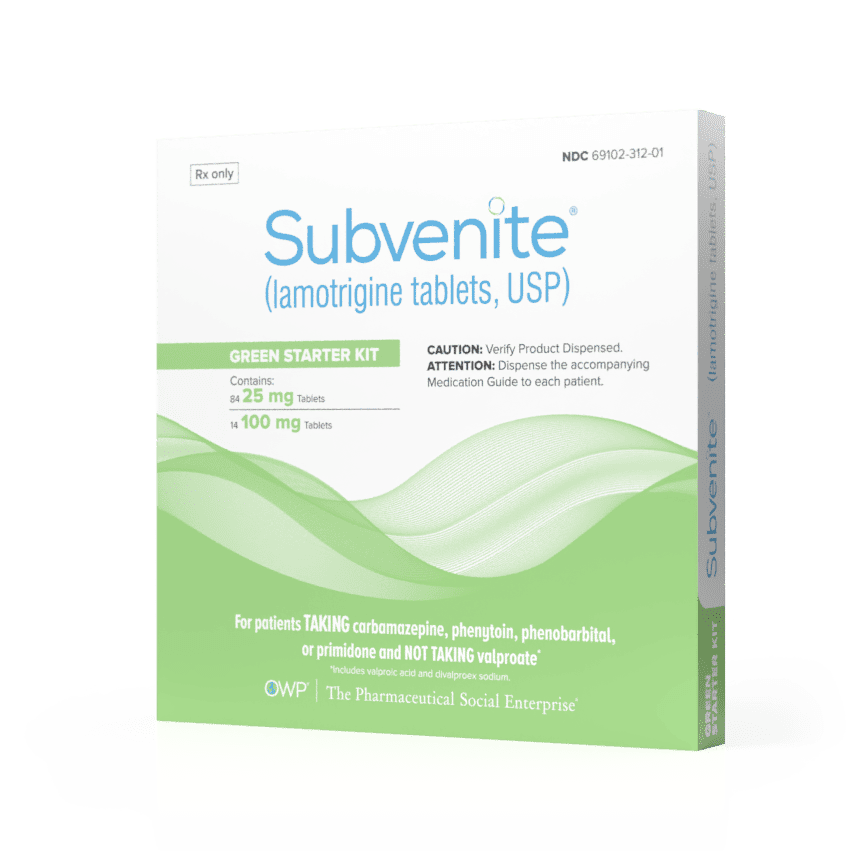NOW AVAILABLE Through ASPN Pharmacy
Why Start with Subvenite Starter Kits?
Subvenite Starter Kits help simplify treatment initiation for you and your patients in a more structured way than is offered by multiple weekly prescriptions and a bottle of 25 mg tablets
Each Kit is based on FDA-approved 5-week titration schedules for patients initiating lamotrigine therapy
You only need to write one prescription for a 5-week Starter Kit
Each Kit comes with a week-by-week blister pack with perforated daily dosing for on-the-go use
With the Savings Card all patients can obtain the Subvenite Starter Kit at a significantly lower cost than Lamictal®*†1
How to Write
A
E-Prescribe
- In your EMR system, type in “Subvenite”
- Look for “Subvenite” Orange, Blue or Green Starter Kit (or dose pack)
- Select the appropriate Kit by clicking on it
- Select the DAW-1 box (may say brand medically necessary, etc.)
- Save the selected Subvenite Starter Kit as a "favorite" for quick access in the future
B
Write DAW-1*
Write Subvenite Starter Kit (Orange, Blue, and Green) DAW-1


Orange Starter Kit: Total 49 Tablets
(42 X 25mg) (7 X 100mg)
NDC 69102-300-01

Blue Starter Kit: Total 35 Tablets
(35 X 25mg)
NDC 69102-306-01

Green Starter Kit: Total 98 Tablets
(84 X 25mg) (14 X 100mg)
NDC 69102-312-01
Pharmacists: Please use the NDC numbers listed above to place orders.
Where to Prescribe
In addition to Nationwide Retail Pharmacy Availability, OWP Patient Support administered by ASPN Pharmacies provides a dedicated service designed to help with access to Lamotrigine Starter Kits.
Dedicated and trained staff
Pharmacy Benefits investigation
Copay assistance
Prior authorization support
Free delivery
To Get Started with OWP Patient Support
1
In your EHR, save:
ASPN Pharmacies
ZIP: 07932
NCPDP#: 3147863
NPI: 1538590690
2
Send Lamotrigine Starter Kit Rx to ASPN Pharmacies
ePrescribe via EHR
3
Remind patients to confirm their Rx with ASPN Pharmacies
Ask them to respond to ASPN’s text or save 1-866-878-4625 as the contact “ASPN Pharmacies” in their phone
You are done! ASPN Pharmacy will contact your office directly if additional information is needed. They will work with your patient to get their prescription filled and delivered to them as soon as possible.
SUBVENITE STARTER KIT INFORMATION FOR THE PHARMACIST
Available through the wholesalers Amerisource, ANDA, Cardinal, McKesson, Smith, Morris & Dickson, Mutual, and others. If you have any questions, please contact OWP PHARMACEUTICALS at 1-800-273-6729
OWP PHARMACEUTICALS’ DRUGS
- Lamotrigine Starter Kits
- SUBVENITE® (lamotrigine) Starter Kits
- ROWEEPRA® (levetiracetam)

A portion of the profits from each Subvenite Starter Kit prescription helps treat people with neurological disorders in under-resourced areas globally. Please visit www.rowglobal.org ↗ to learn more.
References
1. https://www.goodrx.com/lamictal?dosage=49-tablets-of-25mg-and-100mg-orange&form=kit&label_override=Lamictal&quantity=1
2. Center for Drug Evaluation and Research. Guidance for Industry: Statistical Approaches to Establishing Bioequivalence. Silver Spring, MD: Food and Drug Administration, US Department of Health and Human Services; 2001. http://www.fda.gov/downloads/Drugs/GuidanceComplianceRegulatoryInformation/Guidances/ucm070244.pdf. Accessed September 26, 2013.
3. Office of Generic Drugs, Center for Drug Evaluation and Research. Approved Drug Products With Therapeutic Equivalence Evaluations. 33rd ed. Silver Spring, MD: Food and Drug Administration, US Department of Health and Human Services; 2013. http://www.fda.gov/downloads/Drugs/DevelopmentApprovalProcess/ucm071436.pdf. Accessed September 26, 2013.
*Lamictal® is a registered trademark of GlaxoSmithKline, Inc.
†Terms and conditions apply; see subvenitestarterkits.com/savings-program
For general questions or inquiries please contact us at: info@owppharma.com
For SUBVENITE Starter Kit questions please contact us at: medinfo@owppharma.com
To report safety-related concerns please contact us at: safety@owppharma.com
OWOS1063V8 3/25
